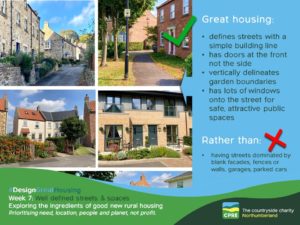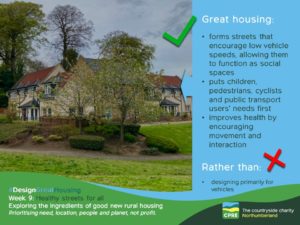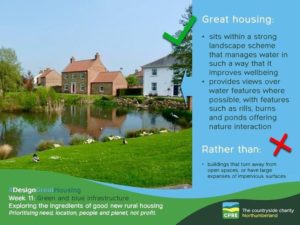How should good new rural housing look?
Prioritising need, location, people and planet, not profit
How do we differentiate great housing from mediocre tick-box schemes? It’s very easy to say what we don’t like, but much harder to define what we do.

CPRE Northumberland’s new campaign launched on Sept 13th, sets out to address the problem. “It’s something we see all the time”, explained Branch Coordinator Annie Lloyd. “New rural housing applications so often have design limitations that we know could easily be improved upon, to the benefit of the community, the environment, and the residents’ wellbeing themselves. The planning process invites critical comment on live applications, without necessarily giving residents the opportunity to input more constructively, setting out what they feel are the ingredients of great housing design.”

The campaign group felt that they could help by engaging public debate, with the aim of facilitating more ‘design literacy’. So, over the space of 12 weeks, the campaign is examining one theme a week, based upon a recently produced set of principles in the ‘Building for a Healthy Life’ toolkit. Recently produced in partnership by Homes England and the NHS, the toolkit sets out 12 widely agreed criteria for great new housing.

Conservation groups such as CPRE, the Countryside Charity, are often derided as NIMBYs, when the reality is of course far more nuanced. Our members care very much about what gets built and where, and appreciate the need for careful balancing of the often competing priorities that change and development present.

We understand that more housing is needed, but this provision must prioritise need, location, people and the planet, over pure profit. CPRE Northumberland’s membership said that their foremost concern in the county at present is the current overwhelm of poor quality, volume housebuilding. As one member explained, “What we don’t need is yet more 4 bed executive ‘anywhere’ housing, with no local facilities. But you can’t expect people to push for better, if they don’t know what better is.

North East needs well-designed, vibrant places that people want to live in – with all homes built for one reason only – to meet demonstrable demand. (We prefer to use the term ‘appropriate’ housing for these homes to counter the stigma often wrongly associated with the term ‘affordable housing’.) Essential to all developments are strong public transport links with easy access to work, leisure and nature.

They need built-in qualities like sustainability, biodiversity, active transport, connectivity, green and blue infrastructure, and at their very core, a quality called ‘good placemaking’. Harder to define, this covers the requirement that development should aim to create distinctive places, rather than the rows of ‘ticky tacky boxes’ that we’ve become used to, and frequently depressed by.

Good placemaking has well-defined, often tree-lined streets that are easy to find your way around, with a memorable character that makes the most of what’s already there. Developments need well-connected layouts that encourage people out of their cars, in favour of active, healthy and climate-conscious transport choices.

CPRE’s campaign has been lent encouragement from Rob Murfin, Northumberland County Council’s Director of Planning. Rob explained that since the Thatcher policies of the 1980s, the public has got used to barren, formulaic developments, with little open space, community resource or infrastructure, and bland identikit design that looks the same whether it is in Hexham or Hastings. There is a feeling that people genuinely don’t know what good housing design looks like. Developers counter this, saying, ‘We build what people want,’ but Rob doesn’t believe this to be true; he asserts that they build what the public have come to expect, and developers themselves exert influence over those expectations. He feels that to create a more engaged and informed public, identifying good local housing exemplars would be a useful starting point.

The campaign was given a major boost recently with an on-line event (on November 1st) where noteworthy speakers explored these and related issues. As well as Rob Murfin, the line up included CPRE’s CEO Crispin Truman OBE, and Nicholas Boys-Smith, founding Director of Create Streets, who is also Chair of the Government’s new Office for Place. It also included representatives of other local and partner organisations promoting good design in our county, such as the North Northumberland Coast AONB Partnership, and the Northumberland & Newcastle Society.

And above all, we want to stimulate public debate. We want to know what sort of housing the public think of as good. Please let us have your input and examples of ‘the good, the bad and the … rest’. Just email Annie (email address at the end of this article).
As Rob Murfin explained, “Current planning engagement centres around asking people to tell us about their places, about what works and what doesn’t. We can then create a Design Guide for developers filled with the features people tell us work best for them.”

And that’s where the next part of the campaign will come in. Building on this year’s momentum, CPRE Northumberland along with partner organisations, are hoping to carry out a much larger on-line digital engagement exercise next year. The aim of this exercise will be to assess local communities’ attitudes to their local environment and housing in rural areas, mapping their responses as a useful tool for the local planning community to take into account going forwards.

You can follow the campaign on our social media Facebook or Twitter pages, or on our website, or contact Annie.CPRE@gmail.com to be put on a mailing list, or to join us as a member.








